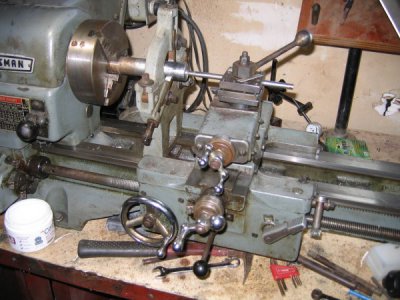- Joined
- Oct 31, 2016
- Messages
- 2,643
When boring the hole I did not move the compound and I was not using the compound to bore the hole. Only the cross feed.
This morning I set up a dial indicator and measured the movement of the cross slide. I did it in both directions and I did two complete revolutions in each direction. I took out the backlash before taking readings. One complete revolution of the cross feed dial moved the cross feed 0.100. I had the same amount of movement in both directions.
Based on Robert's post and my measurements this morning I should have only had to move the cross feed a total of .0625" to enlarge a 1/2" hole to 5/8." I am at a loss as to why I had to move the cross feed almost double this distance to enlarge the hole to 5/8." While I was boring the hole and it became apparent that I was moving the cross feed way more than I thought I should have to move it, I checked my set up over and over and could not find any thing amiss. I was not taking heavy cuts. The biggest cut I took was 0.005."
I have a mystery that I can't solve at this point. Maybe something will come to light when I enlarge the bore in the base plate from 1/2" to 5/8." I will use the exact same setup.
This morning I set up a dial indicator and measured the movement of the cross slide. I did it in both directions and I did two complete revolutions in each direction. I took out the backlash before taking readings. One complete revolution of the cross feed dial moved the cross feed 0.100. I had the same amount of movement in both directions.
Based on Robert's post and my measurements this morning I should have only had to move the cross feed a total of .0625" to enlarge a 1/2" hole to 5/8." I am at a loss as to why I had to move the cross feed almost double this distance to enlarge the hole to 5/8." While I was boring the hole and it became apparent that I was moving the cross feed way more than I thought I should have to move it, I checked my set up over and over and could not find any thing amiss. I was not taking heavy cuts. The biggest cut I took was 0.005."
I have a mystery that I can't solve at this point. Maybe something will come to light when I enlarge the bore in the base plate from 1/2" to 5/8." I will use the exact same setup.


